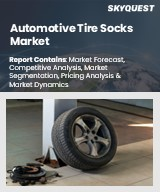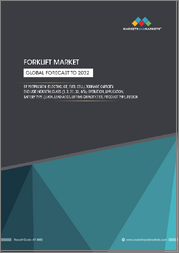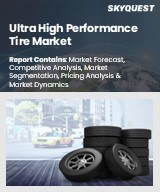
|
시장보고서
상품코드
1757412
세계의 튜브리스 타이어 시장 평가 : 차량 유형별, 기술 유형별, 림 사이즈별, 판매채널별, 지역별 - 기회 및 예측(2018-2032년)Global Tubeless Tire Market Assessment, By Vehicle Type, By Technology Type, By Rim Size, By Sales Channel, By Region, Opportunities and Forecast, 2018-2032F |
||||||
세계 튜브리스 타이어 시장의 CAGR은 5.12%이며, 2024년 2,013억 4,000만 달러에서 2032년 3,002억 달러로 성장할 것으로 예측됩니다. 이 타이어는 림에 직접 밀봉되기 때문에 내부 튜브가 필요 없어 펑크 방지, 발열 감소, 연비 효율이 향상됩니다. 승용차, 상용차, 이륜차, 대형차 등 다양한 부문에 적용되어 세계 시장 성장을 주도하고 있습니다.
레이디얼 구조와 스마트 센서 등의 기술 발전으로 내구성과 성능이 향상되고 있습니다. 소비자와 OEM이 신뢰성, 유지보수 비용 절감, 운전 편의성 향상을 우선시함에 따라 공압 타이어에서 튜브리스 타이어로 전환하는 추세를 보이고 있습니다.
예를 들어, Continental AG는 2025년 3월, 트레이닝, 출퇴근, 장거리 라이딩 등 다양한 용도로 사용할 수 있는 신뢰할 수 있는 만능 타이어를 원하는 사이클리스트들을 위해 튜브리스 대응 성능과 가치를 겸비한 새로운 로드 타이어인 그랑프리 TR을 출시했습니다. 이 타이어는 Continental의 BlackChili 컴파운드와 경량성과 펑크 방지 성능의 균형을 맞춘 새로운 4겹 구조가 특징입니다.
목차
제1장 프로젝트의 범위와 정의
제2장 조사 방법
제3장 미국 관세의 영향
제4장 주요 요약
제5장 고객의 소리
- 응답자 인구통계
- 브랜드 인지도
- 구입 결정시에 고려되는 요소
- 미충족 요구
제6장 세계의 튜브리스 타이어 시장 전망, 2018년-2032년
- 시장 규모 분석과 예측
- 금액별
- 시장 점유율 분석과 예측
- 차량 유형별
- 승용차
- 상용차
- 이륜차
- 기술 유형별
- 래디얼 튜브리스 타이어
- 바이어스 튜브리스 타이어
- 림 사이즈별
- 3-15인치
- 16-18인치
- 19-21인치
- 22-26인치
- 판매채널별
- OEM
- 애프터마켓
- 지역별
- 북미
- 유럽
- 아시아태평양
- 남미
- 중동 및 아프리카
- 기업별 시장 점유율 분석(주요 5개사 및 기타 - 금액별, 2024년)
- 차량 유형별
- 2024년 시장 맵 분석
- 차량 유형별
- 기술 유형별
- 림 사이즈별
- 판매채널별
- 지역별
제7장 북미의 튜브리스 타이어 시장 전망, 2018년-2032년
- 시장 규모 분석과 예측
- 금액별
- 시장 점유율 분석과 예측
- 차량 유형별
- 승용차
- 상용차
- 이륜차
- 기술 유형별
- 래디얼 튜브리스 타이어
- 바이어스 튜브리스 타이어
- 림 사이즈별
- 3-15인치
- 16-18인치
- 19-21인치
- 22-26인치
- 판매채널별
- OEM
- 애프터마켓
- 국가별 점유율
- 미국
- 캐나다
- 멕시코
- 차량 유형별
- 국가별 시장 평가
- 미국의 튜브리스 타이어 시장 전망, 2018년-2032년*
- 시장 규모 분석과 예측
- 시장 점유율 분석과 예측
- 캐나다
- 멕시코
- 미국의 튜브리스 타이어 시장 전망, 2018년-2032년*
적용되는 모든 지역과 국가에 대해 모든 부문이 제공됩니다.
제8장 유럽의 튜브리스 타이어 시장 전망, 2018년-2032년
- 독일
- 프랑스
- 이탈리아
- 영국
- 러시아
- 네덜란드
- 스페인
- 튀르키예
- 폴란드
제9장 아시아태평양의 튜브리스 타이어 시장 전망, 2018년-2032년
- 인도
- 중국
- 일본
- 호주
- 베트남
- 한국
- 인도네시아
- 필리핀
제10장 남미의 튜브리스 타이어 시장 전망, 2018년-2032년
- 브라질
- 아르헨티나
제11장 중동 및 아프리카의 튜브리스 타이어 시장 전망, 2018년-2032년
- 사우디아라비아
- 아랍에미리트(UAE)
- 남아프리카
제12장 Porter의 Five Forces 분석
제13장 PESTLE 분석
제14장 시장 역학
- 시장 성장 촉진요인
- 시장이 해결해야 할 과제
제15장 시장 동향과 발전
제16장 사례 연구
제17장 경쟁 구도
- 시장 리더 주요 5개사의 경쟁 매트릭스
- 주요 5개사의 SWOT 분석
- 시장 주요 기업 10개사의 상황
- Pirelli Tyre SpA
- 기업 개요
- 주요 경영진
- 제공되는 주요 제품
- 주요 재무 상황(보고 시점)
- 주요 시장 초점 및 지역 존재감
- 최근 동향/협업/파트너십/합병과 인수
- CEAT Limited
- Michelin Group
- Apollo Tyres Ltd
- Yokohama Rubber Co., Ltd
- Toyo Tire Corporation
- Goodyear Tire &Rubber Company
- MRF LIMITED
- Hankook Tire &Technology Co., Ltd
- Continental AG
- Pirelli Tyre SpA
위에 언급된 회사는 시장 점유율에 따른 순위를 보유하지 않으며, 조사 작업 중 이용 가능한 정보에 따라 변경될 수 있습니다.
제18장 전략적 제안
제19장 회사 소개 및 면책조항
LSH 25.07.03Global tubeless tire market is projected to witness a CAGR of 5.12% during the forecast period 2025-2032, growing from USD 201.34 billion in 2024 to USD 300.20 billion in 2032F, owing to expanding rapidly driven by vehicle production, safety, and performance benefits. These tires seal directly onto rims, eliminating inner tubes, offering better puncture resistance, reduced heat buildup, and fuel efficiency. Their adoption spans passenger, commercial, two-wheeler, and heavy vehicle segments, driving the global market growth.
Technological advancements such as radial construction and smart sensors are improving durability and performance. A shift from pneumatic tires to tubeless can be witnessed as consumers and OEMs prioritize reliability, lower maintenance costs, and enhanced driving comfort.
For instance, in March 2025, Continental AG launched the Grand Prix TR, a new road tire that combines value with tubeless-ready performance, targeting cyclists seeking a reliable all-round tire for training, commuting, and long-distance rides. The tire features Continental's BlackChili compound and a new 4-ply construction that balances low weight with puncture protection.
Higher Focus on Safety and Performance to Fuel the Tubeless Tire Market Demand
Tubeless tires offer superior safety in high-speed punctures by deflating slowly instead of sudden blowouts. They reduce rolling resistance, minimize heat generation, and improve ride comfort. Easy repair and consistent air retention make them increasingly preferred across vehicle types. With smart features such as TPMS and reinforced radial belts, manufacturers and consumers are drawn to their performance benefits, fueling market growth.
For instance, in June 2024, Michelin SCA launched the X Multi Energy Z+ tyre, its most fuel-efficient offering for commercial vehicles in India. Engineered for Indian roads and load conditions, the tubeless 295/80R22.5 tyre boasts the industry's lowest rolling resistance, delivering up to 15% fuel savings and potentially reducing CO2 emissions by up to eight tons. The tyre also offers 20% longer life than conventional tube tyres and is now available at authorized Michelin India dealerships.
Accelerated vehicle manufacturing, especially in emerging economies, is driving tire demand. The Asia Pacific region leads with the highest percentage of global vehicle production. As disposable incomes rise and infrastructure expands, more consumers buy personal and commercial vehicles. This directly boosts tubeless tire uptake across passenger cars, two-wheeler, and commercial segments. OEMs increasingly specify tubeless units, and replacement cycles grow alongside larger on-road vehicle fleets.
Technological Advancements and Regulations to Shape Tubeless Tire Market Dynamics
Innovation in radial tires, using steel belts and reinforced compounds, enhances durability and fuel efficiency. Integration of smart sensors allows real-time monitoring of pressure, temperature, and wear, appealing to safety and performance-focused users. The development of EV-specific tires with low rolling resistance responds to electrification trends. These enhancements distinguish tubeless tires and bolster their demand among vehicle OEMs and aftermarket players.
For instance, in March 2025, BSM launched the TRANS HARMONY GREEN, the first LNG dual-fuel car carrier added to its managed fleet, operated by its Singapore office. This 3,000-CEU pure car and truck carrier (PCTC) serves the Japan-Southeast Asia route, primarily transporting Toyota vehicles. The vessel exemplifies BSM's commitment to cleaner, sustainable shipping solutions by utilizing LNG dual-fuel technology, enhancing environmental performance while meeting growing demand for eco-friendly maritime transport.
Governments worldwide, especially in APAC and Europe, are mandating fuel-efficient and low-emission tires. The push toward eco-friendly materials and energy-efficient designs spurs the development of low-rolling resistance tubeless variants. EV incentives further boost demand for advanced tire technology. Environmental regulations encourage sustainable manufacturing practices. Together, policy drivers and consumer eco awareness accelerate the transition to tubeless tire solutions.
Passenger Vehicles Lead in the Global Tubeless Tire Market
Based on vehicle type, the passenger cars dominate the tubeless tire market due to higher global registration volumes and frequent replacement cycles. As personal vehicle ownership increases-driven by urbanization, rising incomes, and infrastructure development-car tire demand scales proportionally. OEMs prioritize tubeless tires for their safety benefits and fuel economy, making them standard fitment in new car designs. Additionally, passenger car tires see quicker wear from varied driving conditions, boosting aftermarket replacement rates. The two-wheeler and commercial segments contribute but lag the sheer unit volume of cars. EV adoption further enhances demand for specialized car tires with low rolling resistance.
For instance, in September 2024, Royal Enfield (Eicher Motors Limited) launched new tubeless wire-spoke wheels for the Himalayan 450, addressing a key criticism since its debut. Previously equipped with tube-type tyres, the Himalayan 450 offered tubeless tyres compatible with wire-spoke wheels, enhancing safety and off-road reliability by reducing puncture risks.
Asia-Pacific Dominates the Global Tubeless Tire Market Size
Asia-Pacific holds the largest share of the global tubeless tire market owing to its dominant role in vehicle production and rising domestic demand. Rapid urbanization across China, India, and Southeast Asia has spurred substantial growth in passenger cars, two-wheelers, commercial fleets, and EVs. OEMs and aftermarket players leverage local manufacturing advantages such as lower labor costs, abundant rubber supply, and supportive policies, along with competitive pricing. Infrastructure investments and the adoption of smart transport systems propel demand for advanced, sensor-equipped radial tubeless tires. Additionally, increasing environmental awareness encourages low-rolling resistance and sustainable tire designs. Regional trends also include growing online sales channels, strengthening distribution networks, and local companies launching new products fuel the Asia-Pacific's dominant position in the global tubeless tire market.
For instance, in July 2024, India's JK Tyre & Industries Ltd. launched an advanced range of next-generation tyres for commercial vehicles, introducing four new variants: JETWAY JUM XM, JETWAY JUC XM, JETSTEEL JDC XD, and the innovative JETWAY JUXe for electric buses. These tyres focus on superior performance, fuel efficiency, durability, and sustainability, with the JUXe designed specifically for electric buses to enhance range and reduce noise.
Impact of the U.S. Tariffs on the Global Tubeless Tire Market
Recent U.S. tariffs actions on imported tires have raised costs for manufacturers sourcing from abroad. Higher duties reduce the price competitiveness of foreign-made tubeless tires within the U.S. market. Domestic producers face limited competition but may hike prices due to reduced supply pressure. OEMs relying on global sourcing see margin pressures, prompting some to relocate production or steel/rubber processing closer to the U.S. or diversify suppliers. Meanwhile, aftermarket inflation could shift demand toward replacement tubes or alternative suppliers, slightly dampening the U.S. tubeless tire market growth.
Key Players Landscape and Outlook
Major natural gas vehicle manufacturers focus on vertically integrating manufacturing, from high-pressure tanks and engines to fuel system components, to control costs and ensure supply chain continuity. They forge strategic alliances with gas utilities and energy firms to co-invest in fueling network expansion. Conversion specialists develop plug-and-play kits for retrofitting existing vehicle fleets. Some players offer full-service leasing that bundles vehicles, fueling, and maintenance.
R&D investment is directed toward bi-fuel, dual-fuel and even RNG compatibility to enhance flexibility. Companies also pilot heavy-duty LNG trucks and digital telematics to differentiate offerings. Marketing emphasizes TCO savings and emissions benefits. Government partnerships secure favorable contracts, driving scale. OEMs expand assembly capacity in emerging markets ahead of demand.
For instance, in May 2023, Pirelli Tyre S.p.A. launched the P ZERO Race 4S TLR, an all-season tubeless road bicycle tyre designed to perform in any weather condition. Produced at the renovated Milano-Bollate facility, it features the SmartNET Silica compound for exceptional grip on cold and wet surfaces, and the innovative SPEEDCORE technology with Aramid particulate for smooth rolling, enhanced air retention, and increased puncture protection. Available in 28-622 and 30-622 sizes, and 32-622, it offers a high-performance, racing feel year-round.
Table of Contents
1. Project Scope and Definitions
2. Research Methodology
3. Impact of U.S. Tariffs
4. Executive Summary
5. Voice of Customers
- 5.1. Respondent Demographics
- 5.2. Brand Awareness
- 5.3. Factors Considered in Purchase Decisions
- 5.4. Unmet Needs
6. Global Tubeless Tire Market Outlook, 2018-2032F
- 6.1. Market Size Analysis & Forecast
- 6.1.1. By Value
- 6.2. Market Share Analysis & Forecast
- 6.2.1. By Vehicle Type
- 6.2.1.1. Passenger Vehicles
- 6.2.1.2. Commercial Vehicles
- 6.2.1.3. Two-Wheelers
- 6.2.2. By Technology Type
- 6.2.2.1. Radial Tubeless Tires
- 6.2.2.2. Bias Tubeless Tires
- 6.2.3. By Rim Size
- 6.2.3.1. 3 to 15 inch
- 6.2.3.2. 16 to 18 inch
- 6.2.3.3. 19 to 21 inch
- 6.2.3.4. 22 to 26 inch
- 6.2.4. By Sales Channel
- 6.2.4.1. Original Equipment Manufacturer
- 6.2.4.2. Aftermarket
- 6.2.5. By Region
- 6.2.5.1. North America
- 6.2.5.2. Europe
- 6.2.5.3. Asia-Pacific
- 6.2.5.4. South America
- 6.2.5.5. Middle East and Africa
- 6.2.6. By Company Market Share Analysis (Top 5 Companies and Others - By Value, 2024)
- 6.2.1. By Vehicle Type
- 6.3. Market Map Analysis, 2024
- 6.3.1. By Vehicle Type
- 6.3.2. By Technology Type
- 6.3.3. By Rim Size
- 6.3.4. By Sales Channel
- 6.3.5. By Region
7. North America Tubeless Tire Market Outlook, 2018-2032F
- 7.1. Market Size Analysis & Forecast
- 7.1.1. By Value
- 7.2. Market Share Analysis & Forecast
- 7.2.1. By Vehicle Type
- 7.2.1.1. Passenger Vehicles
- 7.2.1.2. Commercial Vehicles
- 7.2.1.3. Two-Wheelers
- 7.2.2. By Technology Type
- 7.2.2.1. Radial Tubeless Tires
- 7.2.2.2. Bias Tubeless Tires
- 7.2.3. By Rim Size
- 7.2.3.1. 3 to 15 inch
- 7.2.3.2. 16 to 18 inch
- 7.2.3.3. 19 to 21 inch
- 7.2.3.4. 22 to 26 inch
- 7.2.4. By Sales Channel
- 7.2.4.1. Original Equipment Manufacturer
- 7.2.4.2. Aftermarket
- 7.2.5. By Country Share
- 7.2.5.1. United States
- 7.2.5.2. Canada
- 7.2.5.3. Mexico
- 7.2.1. By Vehicle Type
- 7.3. Country Market Assessment
- 7.3.1. United States Tubeless Tire Market Outlook, 2018-2032F*
- 7.3.1.1. Market Size Analysis & Forecast
- 7.3.1.1.1. By Value
- 7.3.1.2. Market Share Analysis & Forecast
- 7.3.1.2.1. By Vehicle Type
- 7.3.1.2.1.1. Passenger Vehicles
- 7.3.1.2.1.2. Commercial Vehicles
- 7.3.1.2.1.3. Two-Wheelers
- 7.3.1.2.2. By Technology Type
- 7.3.1.2.2.1. Radial Tubeless Tires
- 7.3.1.2.2.2. Bias Tubeless Tires
- 7.3.1.2.3. By Rim Size
- 7.3.1.2.3.1. 3 to 15 inch
- 7.3.1.2.3.2. 16 to 18 inch
- 7.3.1.2.3.3. 19 to 21 inch
- 7.3.1.2.3.4. 22 to 26 inch
- 7.3.1.2.4. By Sales Channel
- 7.3.1.2.4.1. Original Equipment Manufacturer
- 7.3.1.2.4.2. Aftermarket
- 7.3.1.2.1. By Vehicle Type
- 7.3.1.1. Market Size Analysis & Forecast
- 7.3.2. Canada
- 7.3.3. Mexico
- 7.3.1. United States Tubeless Tire Market Outlook, 2018-2032F*
All segments will be provided for all regions and countries covered
8. Europe Tubeless Tire Market Outlook, 2018-2032F
- 8.1. Germany
- 8.2. France
- 8.3. Italy
- 8.4. United Kingdom
- 8.5. Russia
- 8.6. Netherlands
- 8.7. Spain
- 8.8. Turkey
- 8.9. Poland
9. Asia-Pacific Tubeless Tire Market Outlook, 2018-2032F
- 9.1. India
- 9.2. China
- 9.3. Japan
- 9.4. Australia
- 9.5. Vietnam
- 9.6. South Korea
- 9.7. Indonesia
- 9.8. Philippines
10. South America Tubeless Tire Market Outlook, 2018-2032F
- 10.1. Brazil
- 10.2. Argentina
11. Middle East and Africa Tubeless Tire Market Outlook, 2018-2032F
- 11.1. Saudi Arabia
- 11.2. UAE
- 11.3. South Africa
12. Porter's Five Forces Analysis
13. PESTLE Analysis
14. Market Dynamics
- 14.1. Market Drivers
- 14.2. Market Challenges
15. Market Trends and Developments
16. Case Studies
17. Competitive Landscape
- 17.1. Competition Matrix of Top 5 Market Leaders
- 17.2. SWOT Analysis for Top 5 Players
- 17.3. Key Players Landscape for Top 10 Market Players
- 17.3.1. Pirelli Tyre S.p.A
- 17.3.1.1. Company Details
- 17.3.1.2. Key Management Personnel
- 17.3.1.3. Key Products Offered
- 17.3.1.4. Key Financials (As Reported)
- 17.3.1.5. Key Market Focus and Geographical Presence
- 17.3.1.6. Recent Developments/Collaborations/Partnerships/Mergers and Acquisition
- 17.3.2. CEAT Limited
- 17.3.3. Michelin Group
- 17.3.4. Apollo Tyres Ltd
- 17.3.5. Yokohama Rubber Co., Ltd
- 17.3.6. Toyo Tire Corporation
- 17.3.7. Goodyear Tire & Rubber Company
- 17.3.8. MRF LIMITED
- 17.3.9. Hankook Tire & Technology Co., Ltd
- 17.3.10. Continental AG
- 17.3.1. Pirelli Tyre S.p.A
Companies mentioned above DO NOT hold any order as per market share and can be changed as per information available during research work.



















